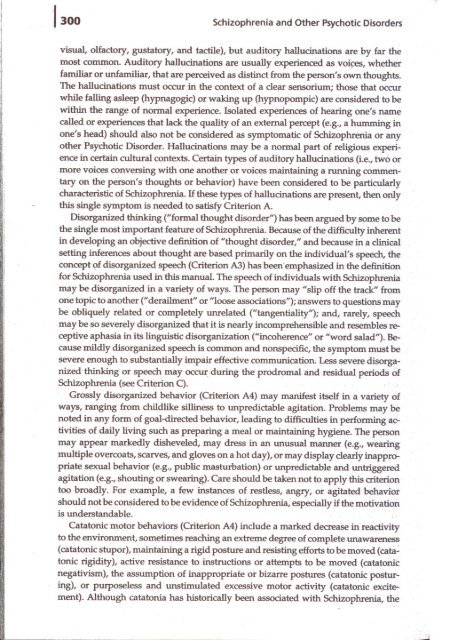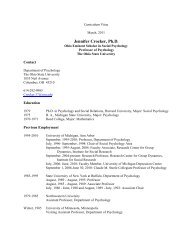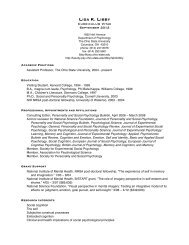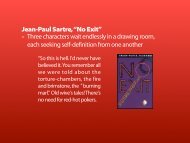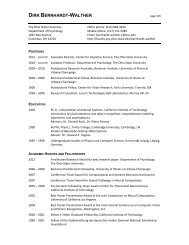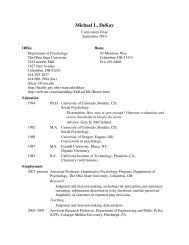Schizophrenia and Other Psychotic Disorders pg297-315.pdf
Schizophrenia and Other Psychotic Disorders pg297-315.pdf
Schizophrenia and Other Psychotic Disorders pg297-315.pdf
You also want an ePaper? Increase the reach of your titles
YUMPU automatically turns print PDFs into web optimized ePapers that Google loves.
Ili<br />
1300 <strong>Schizophrenia</strong> <strong>and</strong> <strong>Other</strong> <strong>Psychotic</strong> <strong>Disorders</strong><br />
visual, olfactory, gustatory, <strong>and</strong> tactile), but auditory hallucinations are by far the<br />
most common. Auditory hallucinations are usually experienced as voi~~ whether<br />
familiar or unfamiliar, that are perceived as distinct from the person's own thoughts.<br />
The hallucinations must occur in the context of a clear sensorium; those that occur<br />
while falling asleep (hypnagogic) or waking up (hypnopompic) are considered to be<br />
within the range of normal experience. Isolated experiences of hearing one's name<br />
called or experiences that lack the quality of an external percept (e.g., a humming in<br />
one's head) should also not be considered as symptomatic of <strong>Schizophrenia</strong> or any<br />
other <strong>Psychotic</strong> Disorder. Hallucinations may be a normal part of religious experience<br />
in certain cultural contexts. Certain types of auditory hallucinations (i.e., two or<br />
more voices conversing with one another or voices maintaining a running commentary<br />
on the person's thoughts or behavior) have been considered to be particularly<br />
characteristic of <strong>Schizophrenia</strong>. If these types of hallucinations are present, then only<br />
this single symptom is needed to satisfy Criterion A.<br />
Disorganized thinking ("formal thought disorder") has been argued by someto be<br />
the single most important feature of <strong>Schizophrenia</strong>. Because of the difficulty inherent<br />
in developing an objective definition of "thought disorder," <strong>and</strong> because in a clinical<br />
setting inferences about thought are based primarily on the individual's speech, the<br />
concept of disorganized speech (Criterion A3) has been'emphasized in the definition<br />
for <strong>Schizophrenia</strong> used in this manual. The speech of individuals with <strong>Schizophrenia</strong><br />
may be disorganized in a variety of ways. The person may "slip off the track" from<br />
one topic to another ("derailment" or "loose associations"); answers to questions may<br />
be obliquely related or completely unrelated ("tangentiality"); <strong>and</strong>, rarely, speech<br />
may be so severely disorganized that it is nearly incomprehensible <strong>and</strong> resembles receptive<br />
aphasia in its linguistic disorganization ("incoherence" or "word salad"). Because<br />
mildly disorganized speech is common <strong>and</strong> nonspecific, the symptom must be<br />
severe enough to substantially impair effective communication. Less severe disorganized·<br />
thinking or speech may occur durfug the prodromal <strong>and</strong> residual. periods of<br />
<strong>Schizophrenia</strong> (see Criterion C).<br />
Grossly disorganized behavior (Criterion A4) may manifestitself in a variety of<br />
ways, ranging from childlike silliness to unpredictable agitation. Problems may be<br />
noted in any form of goal-directed behavior, leading to difficulties in performing activities<br />
of daily living such as preparing a meal or maintaining hygiene. The person<br />
may appear markedly disheveled, may dress in an unusual manner (e.g., wearing<br />
multiple overcoats, scarves; <strong>and</strong> gloves on a hot day), or may display clearly iruippropriate<br />
sexual behavior (e.g., public masturbation) or unpredictable <strong>and</strong> untriggered<br />
agitation (e.g., shouting or swearing); Care should be taken not to apply this criterion<br />
too broadly. For example, a few instances of restless, angry, or agitatedbehaviot<br />
should not be considered to be evidence of Schizophrema, especially if the motivation<br />
is underst<strong>and</strong>able.<br />
Catatonic motor behavio~ (Criterion A4) include a marked decrease in reactivity<br />
to the environment, sometimes reaching an extreme degree of complete unawareneSs<br />
(catatonic stupor), maintaining a rigid posture <strong>and</strong> resisting efforts to be moved (cata~<br />
tonic rigidity), active resistance to instructions or attempts to be moved (catatornc<br />
negativism), the assumption ofinappropriafe or bizarre postures (catatonic posturing),<br />
or purposeless <strong>and</strong> unstimulatedexcessive motor activity (catatonic excite'ment).<br />
Although catatonia has historically been assOciated with <strong>Schizophrenia</strong>, the


